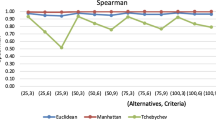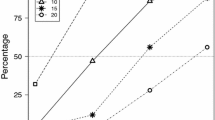Abstract
In a multicriteria decision problem it may happen that the preference of the decision-maker on some criterion is modeled by means of a semiorder structure. If the available information is qualitative, one often needs a numerical representation of the semiorder. We investigate the set of representations of a semiorder and show that, once a unit has been fixed, there exists a minimal representation. This representation can be calculated by linear programming and exhibits some interesting properties: all values are integer multiples of the unit and are as scattered as possible in the sense that, in the set of all representations contained in the same bounded interval, the minimal representation is a representation for which the minimal distance between two values is maximal. The minimal representation can also be interpreted as a generalisation of the rank function associated to linear orders.
Similar content being viewed by others
References
Berge, C.: 1973, Graphes et Hypergraphes. 2nd ed., Dunod, Paris.
Doignon, J.-P., Monjardet, B., Roubens, M. and Vincke, Ph.: 1986, ‘Biorder Families, Valued Relations and Preference Modelling’, J. Math. Psychol. 30, 435–480.
Doignon, J.-P.: 1987a, ‘Threshold Representation of Multiple Semiorders’, SIAM J. Alg. Disc. Meth. 8(1), 77–84.
Doignon, J.-P.: 1987b, ‘Partial Structures of Preference’, in Nonconventional Preference Relations in Decision Making. Kacprzyk, J. and Roubens, M. (Eds.), Springer, Berlin.
Fishburn, P. C.: 1970, Utility Theory for Decision Making. Wiley, New York.
Fishburn, P. C.: 1983, ‘Threshold-bounded Interval Orders and a Theory of Picycles’, SIAM J. Alg. Disc. Meth. 4(3), 290–305.
Fishburn, P. C.: 1985, Interval Orders and Interval Graphs. Wiley, New York.
Hillier, F. S. and Lieberman, G. J.: 1974, Operations Research. Holden-Day, San Francisco.
Jacquet-Lagrèze, E.: 1978, ‘Représentation de quasi-ordres et de relations probabilistes transitives sous forme standard et méthodes d'approximation’. Math. et Sciences Humaines 63, 11–24.
Luce, R. D.: 1956, ‘Semiorders and a Theory of Utility Discrimination’, Econometrica 24, 178–191.
Monjardet, B.: 1978, ‘Axiomatiques et propriétés de quasi-ordres’. Math. et Sciences Humaines 63, 51–82.
Monjardet, B. and Jacquet-Lagrèze, E.: 1978, ‘Modélisation des préférences et quasi-ordres. Avant-propos’. Math. et Sciences Humaines 63, 5–10.
Roy, B.: 1970, Algèbre Moderne et Théorie des Graphes. 2 volumes, Dunod, Paris.
Roy, B.: 1980, ‘Préférence, indifférence, incomparabilité’, Documents du LAMSADE No. 9, Université de Paris-Dauphine.
Roy, B. and Vincke, Ph.: 1987, ‘Pseudo-orders: definition, properties and numerical representation’, Math. Soc, Sc. 14, 263–274.
Roubens, M. and Vincke, Ph.: 1985, Preference Modelling. Lecture Notes in Economics and Mathematical Systems 250, Springer, Berlin.
Author information
Authors and Affiliations
Rights and permissions
About this article
Cite this article
Pirlot, M. Minimal representation of a semiorder. Theor Decis 28, 109–141 (1990). https://doi.org/10.1007/BF00160932
Issue Date:
DOI: https://doi.org/10.1007/BF00160932




